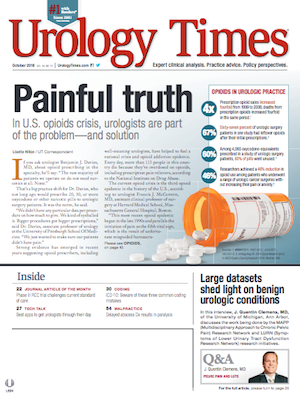Publication
Article
Urology Times Journal
Novel method in the diagnostic arsenal for prostate cancer
Author(s):
"The list of methods and biomarkers to help patients and physicians decide whether to perform biopsy is continuously evolving," writes Sigrid Carlsson, MD, PhD, MPH.
Dr. Carlsson is assistant attending epidemiologist, departments of surgery (urology service) and epidemiology and biostatistics, Memorial Sloan Kettering Cancer Center, New York, and department of urology, Sahlgrenska Academy at the University of Gothenburg, Gothenburg, Sweden.
Screening for prostate cancer by measuring the concentration of PSA in blood is a contentious issue, as the specificity of the PSA test is modest. The scientific community is working to develop novel methods to distinguish aggressive from indolent prostate cancer.
The list of methods and biomarkers to help patients and physicians decide whether to perform biopsy is continuously evolving. The 2018 National Comprehensive Cancer Network Prostate Cancer Early Detection guideline suggests considering free/total PSA, phi, 4Kscore, and PCA3-tests that have been evaluated in dozens of scientific papers and thousands of patients, including prospective multicenter evaluations. When any of these methods are used as a “reflex” test in men with an indication for biopsy, they have shown improved accuracy over the PSA test and have significantly reduced the need for biopsy.
Multiparametric magnetic resonance imaging (MRI) is gaining traction as a diagnostic tool in the pre-biopsy setting and has been shown in several large-scale randomized controlled trials to improve the cancer detection rate when combined with transrectal ultrasound fusion biopsies compared to systematic biopsy alone.
Read: Midlife PSA strongly predicts PCa in African-American men
I commend Dr. Klein and colleagues for evaluating a new diagnostic tool that could enhance the field of prostate cancer detection: the IsoPSA assay (see article here). This test utilizes an intriguing laboratory technique that measures the protein structure of free and complex PSA, which is then mathematically converted to a predicted risk of high-grade cancer. In the initial prospective study of 261 men with biopsies and total PSA levels ≥2.0 ng/mL, IsoPSA outperformed total PSA in predicting high-grade prostate cancer (area under the curve [AUC]: 0.81 [95% CI: 0.74–0.86]) and had a favorable “net benefit” (ie, balancing caught vs. missed cancers as well as risks with biopsy) compared to performing biopsies based on a risk calculator (Eur Urol 2017; 72:942–9).
A small prospective validation study of 123 biopsied men with total PSA levels ≥2.0 ng/mL, of whom many had an MRI-guided biopsy in addition to systematic biopsy, confirmed an AUC of 0.82, with a reduction in unnecessary biopsies by 47% and missed/delayed detection of 2% of high-grade cancers (J Urol 2018:199 [suppl]:e1147–8).
While these initial studies are interesting, there is a critically important need for additional large-scale, prospective and comparative studies before we can determine the clinical utility of IsoPSA. For instance, how does the test perform as compared to free/total PSA or other biomarkers based on isoform concentrations, with/without the use of MRI and with/without clinical information in the mathematical model? Answers to this and other questions will decide whether IsoPSA could be a notable addition in our diagnostic arsenal to distinguish aggressive from indolent prostate cancer.























